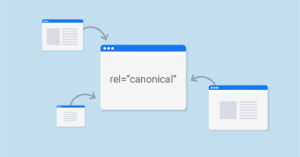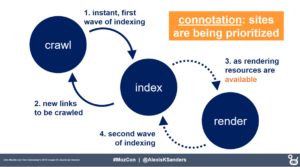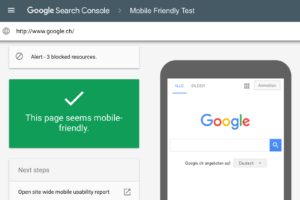SEO’S New Wave: Rendering, Signalling and Connecting
SEO Sydney is sure that you have heard about SEO. If you are here, it’s probably because you want to set up an SEO strategy within your website. In this era of quick changes, SEO is changing too. There’s a Traditional Model who has evolved to the New one. Now, apart from crawling, indexing and ranking, new concepts have appear like rendering, signalling and connecting. But, what’s SEO precisely? It means SEARCH ENGINE OPTIMISATION. Okay, cool. But what is it? And how does it work?
We are talking about a procedure to increase the quantity and quality of a website traffic, as well as, exposing certain online assets on to the organic (non paid) search engine results. Regardless of the name, it is more about people, rather than about search engines. SEO’s aim is to understand what people are looking for, the answers they’re perusing, the words they’re using and the content they would like to consume. Visitors will highly value a brand with the specific tools to answer this questions offering valuable content.
Summarising, creating interesting content for your visitors, you will contribute to the Internet. Offering valuable and relevant content to the search engines will increase the probability of your website being exposed increasingly in the SERPS (Search Engine Results Pages). Now the next question should be, but how do search engines work?!
Search engines have three key processes: Crawling, indexing and ranking.
To crawl means to explore the Internet, to discover new content on the web. After the crawling process, search engines compile and organise the found information. Then, that content will be ready to use as a result to specific or relevant queries. This is the indexing process. At the ranking step, search engines will provide the closest match that will answer visitor’s query according to the indexed information and the score within the algorithm. This process’ name is the triad method or the Traditional SEO Model.
However, considering the wide range of parameters that SEO professionals have to analyse, there’s a necessity to find an extended model to fill the gaps that the traditional doesn’t fill. As a result, the SEO community has devised a further three modules to consider. These being, rendering, signalling and connecting.
The World Wide Web is always changing. It’s the reason why we need to adapt to the ever changing landscape and SEO procedures and that’s where rendering, signalling and connecting come into play.
Nowadays, CSS language, images, JavaScript and customisation are evolving increasingly as time rolls on and rendering, signalling and connecting become more important. To begin, we explain the definitions of rendering, signalling and connecting. Rendering now exists as a new category of SEO ideology to increase on a macro level the capacity of the search engines to find the page’s goal. Status codes and HTML tags are very useful to indicate to Google how to understand and process the page, how to know its intention and classify it and for instance, this is what signalling means. Finally, people are the analytical part of the process. The essence of search engines is to rank and classify content that is interesting for people. Before, “rank” was unidirectional and unfriendly to the website visitors. Now, knowing what users desire is the most important thing, so connecting to them is the key to do an excellent work.
To connect with our customers, we have to understand that they’re humans. We all have a busy life and we have to be relevant to our users’ mind if we want them to remember us. For that purpose, we have to become psychologically important for them because THE BRAIN HOLDS ONLY WHAT’S RELEVANT, USEFUL or INTERESTING FOR SO LONG.
According to this, we have only one chance to become relevant to the users of search engines. If we do it well, we’ll become a friend of them, because“A great brand is like a good friend”. With the goal of website users becoming a close friend of your website, you should ask yourself a bunch of questions, such as:
-Do your users use friendly adjectives to describe you?
-Are you treating your customers as a friend?
-Does your brand’s personality fit with the reality?
-Is all your content useful, relevant or interesting?
-Does your website inspire confidence? And does it have a credible reputation on the World Wide Web?
-Is your content answering your user’s questions?
-Does the site use relevant testimonials and information for your customers?
-Is it equally easy to buy and subscribe as it is to return and cancel?
-Is your contact information easy to find?
Every site’s aim is to be found by search engines. To this end, they have to send precise and effective signals so as not to confuse search engines. That’s the main objective of signalling; to start a preemptive communication with the algorithm, instead of be waiting to be found.
To make this possible, you must be sure that your elements are acting appropriately. Here you are some recommendations to bear in mind:
- Pay attention to your <link> tag, which is the relation between HTML documents and an external style sheets or resources. An HTML document is a text document that organises the website. Different elements are used for this aim:
- rel=”canonical”, also called “canonical link”, is used to prevent duplicate or paraphrased content problems. If similar content appears in different locations on your website, this tag will signal to Google which specific URL has to be shown in the SERPS (SEARCH ENGINE RESULTS PAGES). Using canonical links you will solve this problem. Also, you will show to the search engines which URL is your preferred one. In order to use canonicals:
- You have to make sure that the content is similar.
- Canonical links are written in HTML.
EXAMPLE:
Imagine that you have two pages with the same or very similar valuable content separated in different sections:
https://example.com/sports/soccer/england/
https://example.com/sports/english-soccer/
Using rel=”canonical” as below you’ll signal to Google which one is your preferred page:
- Select one of the pages as your main (canonical).
- Add rel=”canonical” link to the URL that you have chosen. In this example, we’ll add it to the shortest link.
<link rel=”canonical” href=”https://example.com/sports/english-soccer/” />
This tag must be written on the <head> section of your site’s HTML code. Adding this tag, you’ll join to pages into one. From search engines point of view, links from both pages will count as single, and it will make you easier to get found by Google and users.
- rel=”prev” & rel=”next”, is related to indicate the relationship between paginated URLs and distinguish them as series. In this way, using this element you will be able to send users to your most relevant URL quicker because search engines won’t get lost finding it. Hence improving your overall UX (User Experience).
EXAMPLE:
Returning to the first example, imagine that you have different articles divided in pages who are related to the same topic. If you want to create a paginated serie of content, you should add rel=”prev” and rel=”next” tags as they’re shown below:
- Select your main page and add rel=”prev” link to the chosen URL:
<link rel=”prev” “href=”https://example.com/sports/english-soccer/”/>
2. Add rel=”next” to the next URLs:
<link rel=”next” “href=”https://example.com/sports/english-soccer/west-ham/” />
According to this, you could add as many related pages as you want to your website, and Google will always know which one you have decided to be the main one:
- <link rel=”prev” href=”https://example.com/sports/english-soccer/” />
- <link rel=”next” href=”https://example.com/sports/english-soccer/west-ham/” />
- <link rel=”next” href=”https://example.com/sports/english-soccer/liverpool/” />
- <link rel=”next” href=”https://example.com/sports/english-soccer/manchester-united/” />
Using these link tags you’ll be giving Google a very important hint which will let you get an easier and quicker results in the SERPS (Searching Engine Results Pages).
- rel=”alternate”, delineates similarity between two pages and signals which page to preference to Google. This is another way to prevent duplicate content problems. There are two basic tags that you have to be aware of: rel=”alternate” media and rel=”alternate” hreflang. First one is used to indicate the relation between desktop and mobile websites, helping search engines understand which version of your website do you want to serve to users. The second one is to provide information to Google about the language and the audience of a specific website. Using this tag will help you serving the proper regional URL and correct language for each user.
EXAMPLE rel=”alternate” media
If you want to redirect users and search engines to the correct content between your desktop and mobile website, this is what you’d have to do:
- Desktop version: Type rel=”alternate” media in the HTML code to redirect the traffic from desktop to the mobile version.
<link rel=”alternate” media=”only screen and (max-width: 640px)” href=”https://m.website.com/” />
Which means that if user’s device is less than 640 pixel wide, search engines will redirect automatically to the mobile version.
2. Mobile version: Add the canonical URL in your mobile’s HTML code page to redirect the traffic from mobile to desktop version.
<link rel=”canonical” href=”https://website.com/” />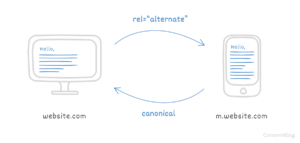
When you create a website in different languages, you will have to specify the language that you want to be found by Google. This also might change depending on the country where users are looking for you. This is the reason why to use the tag link rel=”alternate” hreflang, so the example could be this one:
<link rel=”alternate” hreflang=”en” href=”https://www.example.com/es/” />
- The rel=”alternate” link means that there’s a relation between the website mentioned above and another one.
- The hreflang=”en” provides the information about the language and location of the target.
- The href contains the URL of the mentioned website.
Even though there are different ways to add this link tag to your web, the easiest one is adding the link tag on the HTML’s <head> part. Imagine that your site is for Spain, United Kingdom and France:
<link rel=”canonical” href=” https://www.example.com/es/” />
<link rel=”alternate” hreflang=”es” href=”https://www.example.com/es/” />
<link rel=”alternate” hreflang=”en” hreft=https://www.example.com/uk/ />
<link rel=”alternate” hreflang=”fr” href=”https://www.example.com/fr/” />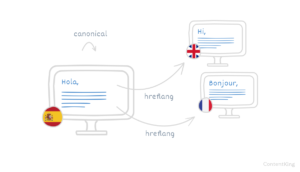
2. Use the Google Search Console so you can make sure that you are sending clear signals and analyse the reports. This tool will help you to monitor and maintain your site’s presence in the SERPS (SEARCH ENGINE RESULTS PAGES).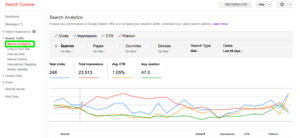
When we talk about rendering a website, we are talking about the ability that search engines have to find a specific page’s core. The main term to focus on the rendering part is JavaScript.
Google searches JavaScript in a second round of the indexing part. In the Old SEO’s Model, content would be crawled instantly on the first wave of the indexing part, finding new links to crawl. Nowadays, on the New Model, there are new resources as rendering, that makes possible to reindex the content deeper:
For an SEO, the most important thing is to ensure that Google is rendering the content. To warrant this, you will have to make sure that you are doing this:
-You are using correct link tags, such as, rel=”alternate”,“hreflang”, “href”, “previous”, “next”, etc.
-You are creating good internal and external links connected with your content, which will finally create an appropriate network and feedback with your website.
-Your content is presented in the DOM. The Document Object Model (DOM), is a computer software and a language-independent Application Programming Interface (API) that structures an HTML document as a tree. Every single part of the tree ends in a link which contains different objects. Presenting your HTML in the DOM will possibly web engines to find your website easier and quicker.
-The content is being correctly indexed. You can check the process using the Google Search Console which will help you monitoring and analysing your reports. Using Google’s Mobile-Friendly Test Tool would be also useful for you to ensure that your website is Mobile friendly, since smartphone traffic has overtaken desktop traffic in many countries.
There is another question that you should ask yourself: Do you really provide valuable content to your users which should be indexed by Google?
Search engine bots are lazy and they will not scroll your whole content. For this reason, you have to be aware of using infinite scroll, which is a tactic to load the content when users arrive to a specific point in the website. Only use this tool in your website on a page that hasn’t a lot of content. There are different methods to avoid search engine’s laziness:
–Distribute the content in different sections or pages.
-As we’ve explained previously, add rel=”next” and rel=”prev” link tags on each page.
-Use lazy loading imagery. This web optimisation tactic loads images while user is scrolling, which will save time downloading images only when it’s needed.
CSS (Cascading Style Sheets) is another term to bear in mind in the rendering process. As we’ve mentioned, HTML’s aim is to write the code. whereas CSS is to add visual characteristics to the website, such as, colouring, stilling, etc. adding images, videos, gifs and so on. The problem is that Google doesn’t index many attributes of CSS. To make this possible, there are some tricks. For example, you can ensure that you add encircled textual content to the CSS animations which search engines will interpret.
Another way to solve the problem is the usage of responsive layouts, which means that the entire layout will respond on the customer’s screen resolution. Users can start reading your website in their mobile and then switch to their tablet or computer, so the browser window will get resized automatically.
If you’ve got a website already, you should be aware of these instructions above to ensure an appropriate traffic to your website, define the target that you want to reach and improve your business’ profitability.
Don’t hesitate to contact us today at SEO Sydney to help you grow your business with rendering, signalling and connecting.




